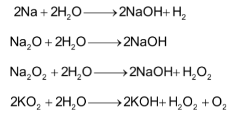General Characteristic Of The Compounds Of The Alkali Metals
S and P Block Elements of Class 11
(i) Oxides and Hydroxides
All the alkali metals, their oxides, peroxides and superoxides readily dissolve in water to produce corresponding hydroxides which are strong alkalies eg

Thus peroxides and superoxides also act as oxidizing agents since they react with  forming H2O2 and
forming H2O2 and  respectively. The hydroxides of all the alkali metals are white crystalline solids. They are strongest of all base and readily dissolve in water with the evolution of much heat.
respectively. The hydroxides of all the alkali metals are white crystalline solids. They are strongest of all base and readily dissolve in water with the evolution of much heat.
(a) Basic Strength
The basic strength of these hydroxides increases as we move down the group Li to Cs. The hydroxides of alkali metals behave as strong bases due to their low ionization energies which decrease down the group. The decrease in ionization energies leads to weakening of the bond between metal and hydroxide ion and M – O bond in M – O – H can easily break giving M+ and OH-. This results in the increased concentration of hydroxyl ions in the solution i.e increased basic characters.
(b) Solubility and stability
All these hydroxides are highly soluble in water and thermally stable except lithium hydroxide.
2 LiOH ——–> Li2O + H2O
(c) Formation of salts with acids:
Alkali metals hydroxides being strongly basic react with all acids forming salts.


(ii) Halides
The alkali metals combine directly with halogens under appropriate conditions forming halides of general formula MX. These halides can also be prepared by the action of aqueous halogen acids (HX) on metals oxides, hydroxides or carbonate.
M2O + 2HX → 2HX + H2O
MOH + HX ——> MX + H2O
M2CO3 + 2 HX ———> 2 MX + CO2 + H2O
All these halides are colourless, high melting crystalline solids having high negative enthalpies of formation.
Table – II [Standard enthalpies of formation in (kJ/mol−1)]
|
Element |
MF |
MCl |
MBr |
MI |
|
Li |
-612 |
-398 |
-350 |
-271 |
|
Na |
-569 |
-400 |
-360 |
-288 |
|
K |
-563 |
-428 |
-392 |
-328 |
|
Rb |
-549 |
-423 |
-389 |
-329 |
|
Cs |
-531 |
-424 |
-395 |
-337 |
The value decreases in the order: Fluoride > Chloride > bromides > Iodide
Thus fluorides are the most stable while iodides are the least stable.
The trends in melting points, boiling points and solubility of alkali metals halides can be understood in terms of polarization effects, lattice energy and hydration of ions.
(a) Polarization effects
|
Comparison of ionic and covalent character of alkali metal halides. When a cation approaches an anion, the electron cloud of the anion is attracted towards the cation and hence gets distorted. This effect is called polarization. The power of the cation to polarize the |
|
anion is called its polarizing power and the tendency of the anion to get polarized is called its polarizability. The greater the polarization produced more is the concentration of the electrons between the two atoms thereby decreasing the ionic character or increasing the covalent character. The covalent character of any compound in general depends upon the following factors.
(i) Size of the cations
Smaller the cation greater is its polarizing power and hence larger is the covalent character. The covalent character decreases as size of cation increases.
LiCl > NaCl > KCl > RbCl > CsCl
Thus LiCl is more covalent than KCl.
(ii) Size of the anion
Larger the anion, greater is its polarizability. This explains the covalent character of lithium halides is in order
LiI > LiBr > LiCl > LiF
(iii) Charge of the ion
Greater the charge on the cation greater is its polarizing power and hence larger is the covalent character. The covalent character of some halides increase in the order

Similarly greater the charge on the anion, more easily it gets polarized thereby imparting more covalent character to the compound formed eg covalent character increase in the order

Thus the covalent character decreases as the charge of the anion decrease.
(iv) Electronic configuration of the cation
If two cations have the same charge and size, the one with pseudo noble gas configuration i.e having 18 electrons in the outermost shell has greater polarizing power than a cation with noble gas configuration i.e having 8 electrons. For eg. CuCl is more covalent than NaCl.
(b) Lattice Energies
lattice energy is defined as the amount of energy required to separate one mole of solid ionic compound into its gaseous ions. Evidently greater the lattice energy, higher is the melting point of the alkali metals halide and lower is its solubility in water
Table – III
|
Compound |
Lattice energy |
Hydration* energy |
Solubility |
Melting point |
|
LiCl |
-845 |
-876 |
63.7 |
887 |
|
NaCl |
-770 |
-776 |
35.7 |
1084 |
|
KCl |
-703 |
-700 |
34.7 |
1039 |
|
RbCl |
-674 |
-680 |
77.0 |
988 |
|
CsCl |
-644 |
-646 |
162 |
925 |
|
NaF |
-893 |
-919 |
4.22 |
1261 |
|
NaCl |
-770 |
-776 |
35.7 |
1028 |
|
NaBr |
-730 |
-745 |
116 |
1084 |
|
NaI |
-685 |
-685 |
184 |
944 |
|
LiF |
-1005 |
-1019 |
0.27 |
1115 |
|
CsI |
-582 |
-670 |
44.0 |
1115 |
(c) Hydration Enthalpy
It is the amount of energy released when one mole of gaseous ions combine with water to form hydrated ions.
M+ (g) + aq ——–> M+(aq) + hydration enthalpy
X‾(g) + aq ——–> X‾ (aq) + hydration enthalpy
Higher the hydration energy of the ions greater is the solubility of the compound in water.
Further the extent of hydration depends upon the size of the ions. Smaller the size of the ion, more highly it is hydrated and hence greater is its hydrated ionic radius and less is its ionic mobility (Conductance).
From above arguments, the melting point and solubility in water or organic solvent of alkali metal halides can be explained
(i) A delicate balance between lattice enthalpy and hydration enthalpy determines the ultimate solubility of a compound in water. For eg. Low solubility of LiF (0.27 g/100 g ) is due to its high lattice energy
) is due to its high lattice energy  whereas the low solubility of CsI (44g/100g
whereas the low solubility of CsI (44g/100g  ) is due to smaller hydration energy of the two ions (-670 KJ/mol)
) is due to smaller hydration energy of the two ions (-670 KJ/mol)
(ii) The solubility of the most of alkali metal halides except those of fluorides decreases on descending the group since the decrease in hydration energy is more than the corresponding decrease in the lattice energy.
(iii) Due to small size and high electronegativity, lithium halides except LiF are predominatantly covalent and hence are soluble in covalent solvents such as alcohol, acetone, ethyl acetate, LiCl is also soluble in pyridine. In contrast NaCl being ionic is insoluble in organic solvents.
(iv) Due to high hydration energy of Li+ ion, Lithium halides are soluble in water except LiF which is sparingly soluble due to its high lattice energy.
(v) For the same alkali metal the melting point decreases in the order
fluoride > chloride > bromide > iodide
because for the same alkali metal ion, the lattice energies decreases as the size of the halide ion increases.
(vi) for the same halide ion, the melting point of lithium halides are lower than those of the corresponding sodium halides and thereafter they decrease as we move down the group from Na to Cs.
The low melting point of LiCl (887 K) as compared to NaCl is probably because LiCl is covalent in nature and NaCl is ionic.
Salts of oxoacids
Since the alkali metals are highly electropositive, therefore their hydroxides are very strong bases and hence they form salts with all oxoacids  . They are generally soluble in water and stable towards heat. The carbonates
. They are generally soluble in water and stable towards heat. The carbonates  of alkali metals are remarkably stable upto 1273 K, above which they first melt and then eventually decompose to form oxides.
of alkali metals are remarkably stable upto 1273 K, above which they first melt and then eventually decompose to form oxides.  , however is considerably less stable and decomposes readily.
, however is considerably less stable and decomposes readily.

This is presumably due to large size difference between Li+ and  which makes the crystal lattice unstable.
which makes the crystal lattice unstable.
Being strongly basic, alkali metals also form solid bicarbonates. No other metals forms solid bicarbonates though also exists as a solid. Lithium, however does not form solid bicarbonate though it does exist in solution. All the bicarbonate on gentle heating undergo decomposition to form carbonates with the evolution of
also exists as a solid. Lithium, however does not form solid bicarbonate though it does exist in solution. All the bicarbonate on gentle heating undergo decomposition to form carbonates with the evolution of  .
.

All the carbonates and bicarbonates are soluble in water and their solubilities increase rapidly on descending the group. This is due to the reason that lattice energies decrease more rapidly than their hydration energies on moving down the group.
- Introduction
- Physical Properties
- Chemical Properties
- General Characteristic Of The Compounds Of The Alkali Metals
- Anomalous Behaviour Of Lithium And Its Diagonal Relationship With Magnesium
- Difficulties Encountered During Extraction Of Alkali Metals
- Sodium
- Compounds Of Alkali Metals
- Alkaline Earth Metals
- Extraction Of Lithium
- Chemical Properties Of Group II elements
- Anamalous Behaviours Of Beryllium
- Manufacture Of Cement
- Silicon
- Exercise 1
- Exercise 2
- Exercise 4
- Exercise 5
- Exercise 6
- Exercise 7
- Exercise 8










